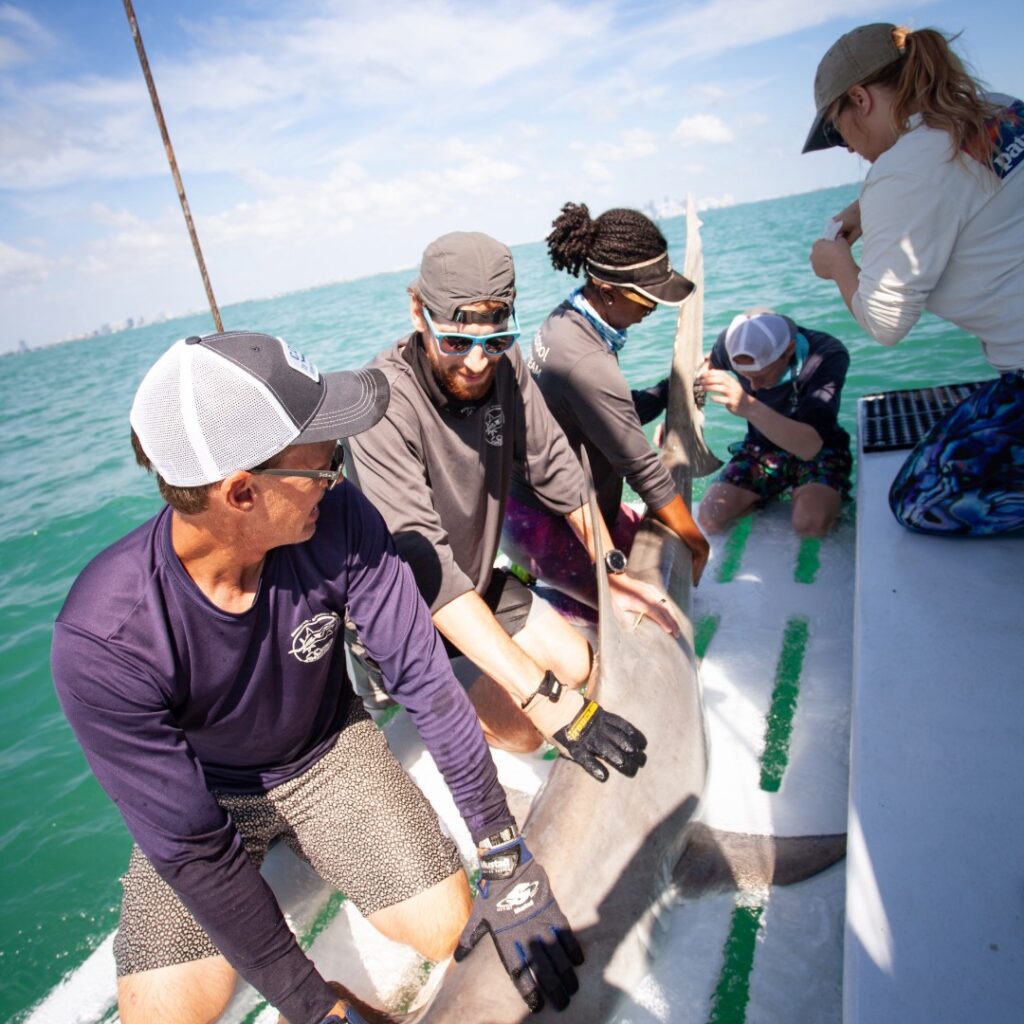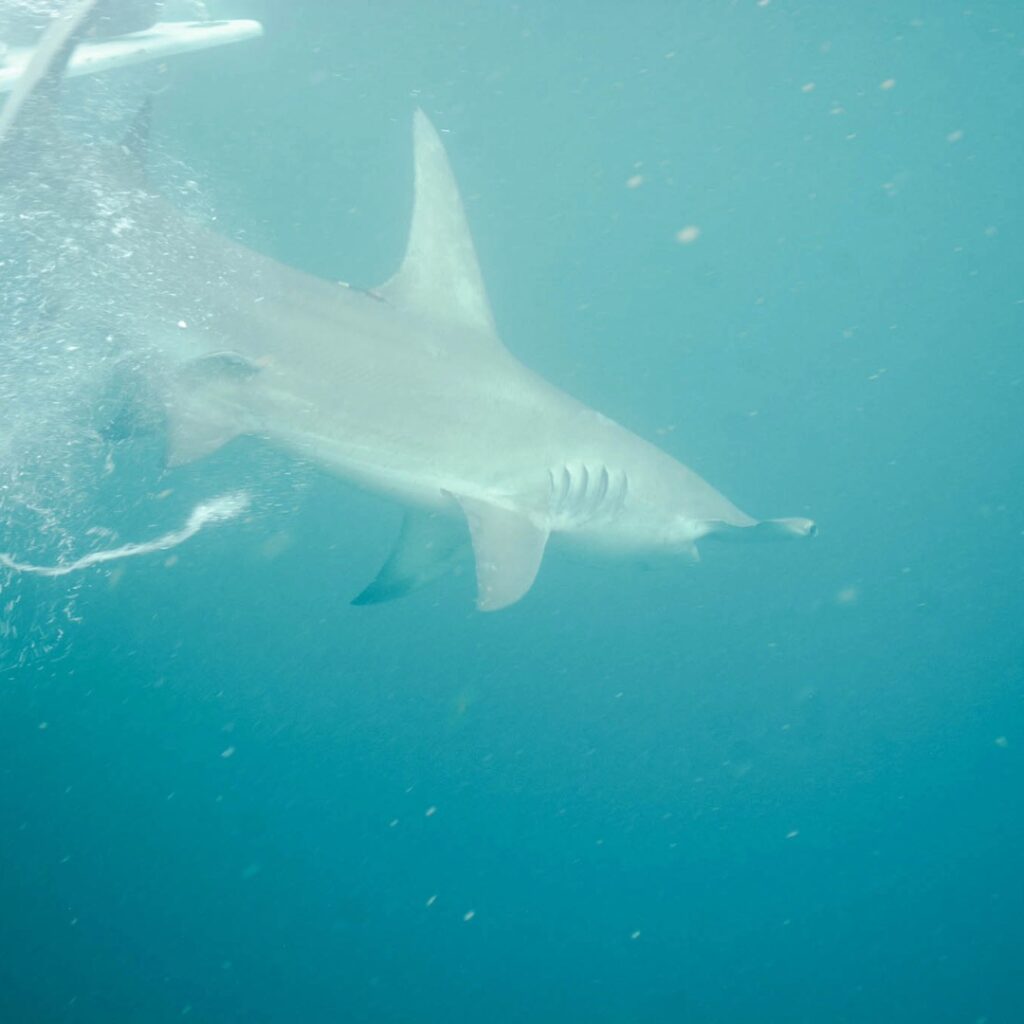John Hlavin is a PhD student in the Shark Research and Conservation Program of the University of Miami Rosenstiel School of Marine, Atmospheric, and Earth Science. John was awarded the FSG/Guy Harvey Fellowship in 2024.

Image by Jackson Cole, Field School.
With Discovery’s Shark Week and NatGeo’s Sharkfest around the corner, shark programming from all over the world is poised to take over our televisions once more. Growing up, these shows led me to believe that one-of-a-kind study sites could only be found halfway around the world’s oceans, not right in my backyard. But when I joined the Shark Research and Conservation Lab at the University of Miami, I was blown away to find out that Biscayne Bay, the estuary situated quite literally in the shadow of metropolitan Miami, is the only formally identified nursery area for the Critically Endangered great hammerhead shark on the East Coast of the United States.
The seagrass, mangrove, and coral reef habitats of Biscayne Bay and the nearby Atlantic are home to a biodiverse shark community that ranges from the charismatic tiger, hammerhead, lemon, bull, and nurse sharks to the often-overlooked blacknose, blacktip, sharpnose, spinner, and bonnethead sharks. The urbanization of Biscayne Bay is a threat to these ecosystems and its shark community has been associated with declines in the quality of local juvenile shark diets. The threats juvenile hammerheads face from both other sharks (both potential competitors and/or predators) and human activity begs the question: how are nursery hammerheads able to use Biscayne Bay to their advantage?
Shark nurseries are traditionally regarded as areas where juveniles are sheltered from predation and provided with abundant food. But as any fellow parent knows, childcare can be costly; an experience we very well might share with the hammerhead. Over the past few months, as I balanced work with staying home with my 7-month-old daughter, my research began to suggest that life in the nursery might not be all lullabies and baby bottles for young hammerheads either. Instead, the benefits of nursery dependence are vulnerable to disturbances in their prey and habitat resources, something that populous destination cities are unfortunately quite good at.

Image by Jackson Cole, Field School.
To uncover and direct conservation attention to the critical prey and habitat resources used by nursery hammerheads, I have undertaken a minimally invasive multi-method approach. First, using stable isotope analysis of muscle and plasma tissue, a method that takes advantage of the predictable way naturally occurring isotopes of carbon and nitrogen move through the food web and an organism’s tissues, I am quantifying their niche (i.e., the diversity of dietary and habitat resources used) and whether it might be influenced by age, season, or competition with other members of the local shark community.
All signs so far point to a smaller constrained niche in nursery juveniles. Unfortunately, regardless of whether their small niche size is imposed by competition with other sharks, foraging constraints due to predation risk, food scarcity, or is a product of adaptive specialization on a certain diet, a small niche is associated with an inflexibility to switch to alternatives if a subset of resources becomes less accessible. Therefore, in the future, I plan to analyze DNA from hammerhead fecal material obtained via a swab of the cloaca (where waste is expelled) to precisely reconstruct the diet of juvenile hammerheads via a method known as metabarcoding to identify what prey they have been consuming from a small but taxonomically unique DNA sequence (similar to scanning a store item’s barcode).
My research hopes to ensure the data needed to protect the nursery is available to managers. To date, no management strategies have been implemented for Biscayne Bay to formally address the area’s function as a hammerhead nursery. While Florida shark fishing regulations prohibit targeting or harvesting great hammerheads and require that they remain in the water for immediate release, we must ask ourselves, can we do more to protect juvenile great hammerheads? Protection from fishing pressure is surely insufficient if we do not also ensure it has continued access to the prey and habitat resources on which it depends.
So, this Shark Week, remember that sharks and humans may have more in common than you would expect! Stability is so important during our “nursery” years, because for sharks and humans alike, growing up will always be hard.